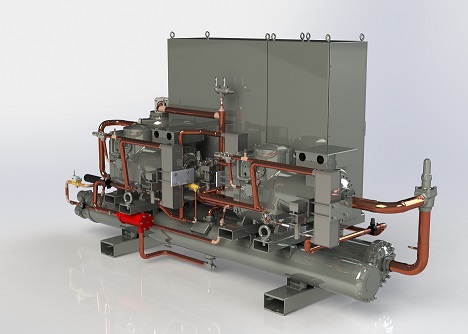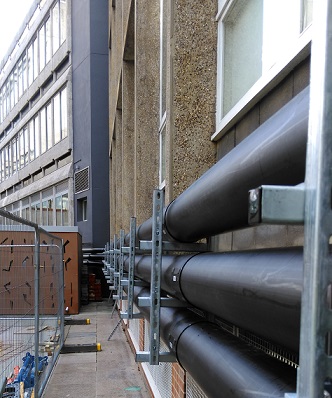District Heating & Cooling
Heat Sharing Network™
Heat sharing between buildings on the same network
A Heat Sharing Energy Network is the ideal energy saving tool: it enables heat to be recycled from those buildings which need to reject heat to those buildings which need heating.
A Heat Sharing Network connects a number of buildings with a piped water circuit from which a heat pump in each building can extract heat, if it needs heating, or reject heat, if it needs cooling.
Heat Sharing Dividend
In this way each of the buildings on the network can heat exchange with the common network circuit and exchange heat between themselves. Those buildings which reject heat to the network provide benefit to those that need heat. Those that take heat from the network benefit those which need cooling. When heating and cooling is engaged simultaneously then both buildings benefit from a "heat sharing dividend".
A Heat Sharing Network is also connected to a common ground array, so that if all buildings on the circuit need heating simultaneously then heat can be recovered from a borehole array in the ground. Alternatively heat can be recovered from an aquifer, or rejected to an aquifer if all buildings on the circuit require cooling at the same time.
This provides is a new form of district heating that circulates water at near ground temperature to each building on the network and largely eliminates the loss of heat to the ground that is suffered by district heating circuits fed by a central Combined Heat and Power engine at high temperature. There is no requirement for a heavily insulated pipe circuit that is needed to save heat losses when operating a high temperature circuit.
A Heat Sharing Network can also be termed an Ambient Temperature Heat Network, or ambient temperature district heating: it is the modern way to provide district heating and cooling.
The advantages of a Heat Sharing Network
The advantages of a Heat Sharing Network are that it:
- is cheaper to install than a CHP-based district heating network
- is cheaper to run than a CHP network
- relies on heat transfer provided by heat pumps in each building
- does not employ combustion – or release any CO2 on site
- does not release any NOx or SOx on site – so improves local air quality
- provides cooling in summer, as well as heating in winter
- allows each building to control (and pay) for its own heating / cooling needs
- allows each building to earn revenue from the Renewable Heat Incentive
The advantages of a Balanced Energy Network
The heat balancing advantages of a Heat Sharing Network can be further extended if the design incorporates Demand Side Response to save on the cost of electricity and help to balance supply and demand of electricity on the National Grid.
Including large thermal energy storage tanks permits further balancing, as does a control system that is tuned to balance the temperature in a building with the thermal inertia of the building itself.
A Balanced Energy Network can serve new buildings and existing buildings
A BEN can serve new buildings that are designed to be heated using modern heat emitter systems such as underfloor heating, or air handling systems, that require lower flow temperatures of around 40°C.

A BEN can also serve older buildings that have been designed to be heated using heat emitter systems that require flow temperatures of 80°C to work well, such as radiators. In these cases it will be appropriate to specify high temperature heat pumps that are capable of delivering temperatures of 80°C in order to avoid the disruption of renovating the building with modern heat emitting systems.
Zero Carbon District Heating
A heat sharing network emits zero carbon on-site. If the electricity used by the heat pumps is generated from green electricity, then the district heating and cooling system is a zero carbon heating network.
Duality of Purpose
New buildings are frequently serviced by gas boilers for their heating needs and by roof mounted chillers for their cooling needs in summer: the capital outlay of providing two separate systems is larger than the cost of providing ground source energy from which heat pumps can provide heating in winter, and cooling in summer from the same system.
The running cost of providing cooling by heat exchange with the ground is radically less expensive than providing cooling by heat exchange with hot air.
The running cost of providing heating by heat exchange with the ground is less than the cost of burning fossil fuels - especially when the benefit of the Renewable Heat Incentive is factored in.
One integrated system can be relied on to provide a duality of purpose.
See also article on: Heat Networks - Code of Practice.


